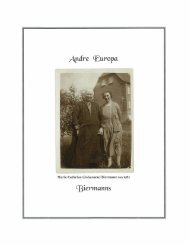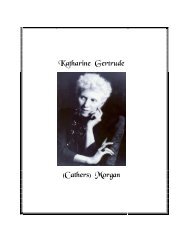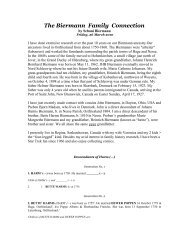A Collection of Dad's Essay's & Writings - Welcome
A Collection of Dad's Essay's & Writings - Welcome
A Collection of Dad's Essay's & Writings - Welcome
You also want an ePaper? Increase the reach of your titles
YUMPU automatically turns print PDFs into web optimized ePapers that Google loves.
- Adventures Above the Clouds -<br />
"When once you have tasted flight,<br />
you will forever walk the earth<br />
with your eyes turned skyward,<br />
for there you have been,<br />
and there you will always long to return."<br />
Amelia Earhart Charles Lindbergh<br />
he risks were great but a whole roster <strong>of</strong> adventurous men and women made aviation history and<br />
thrilled millions <strong>of</strong> people around the world during two decades. From the end <strong>of</strong> the First World<br />
War until the commencement <strong>of</strong> the Second World War, the thrill <strong>of</strong> conquest was for many high<br />
above the clouds. The names <strong>of</strong> countless men and women who took to the air are largely forgotten<br />
with the exception <strong>of</strong> a few which the contemporary media, in its narrow concept, has kept alive. For<br />
young people living during the late 1920’s and the depression years <strong>of</strong> the 1930’s, there were many<br />
heroes and heroines, but a number <strong>of</strong> them were on the silver screen <strong>of</strong> Hollywood movies. Ken<br />
Maynard, Buck Jones, Bob Steel, Tim McCoy and Hoot Gibson were household names. In the sports world, it was<br />
Babe Ruth, Lou Gehrig, Jimmy Foxxe and Dizzy Dean who dominated baseball while Charlie Conacher, Milt Schmidt,<br />
Toe Blake, Howie Morenz and Nels were greatly admired by hockey fans. Young people with a sense <strong>of</strong> adventure and<br />
some imagination were thrilled by the exploits <strong>of</strong> explorers, racing car drivers, speedboat racers and perhaps most <strong>of</strong><br />
all, the early flyers who were undaunted in their intentions to fly the Atlantic, or make similar conquests elsewhere.<br />
Ever since Lindbergh flew from North America to Paris in 1927 this became something <strong>of</strong> a new frontier and the<br />
young and old alike were caught up in the excitement <strong>of</strong> history in the making. In the next six years the leading<br />
aviators and aviatrixes became the new heroes and heroines. The early pioneers had been the Wright Brothers, Louis<br />
Bleriot flying the Channel, Alcott land Brown conquering the Atlantic and Floyd Bennett and Richard Byrd flying over<br />
the Pole as well as JAD McCurdy lifting <strong>of</strong>f the ground at Baddeck in Cape Breton.<br />
There may have been some people with a vision <strong>of</strong> the future <strong>of</strong> flying. But unfortunately the early use <strong>of</strong><br />
airplanes was during the period <strong>of</strong> 1914-1918 and there was no vision here other than to destroy. Romanticized<br />
versions <strong>of</strong> flying aces really came later with literary and film projects making heroes <strong>of</strong> young lads needlessly dying.<br />
Manufacturers <strong>of</strong> flying machines were not thinking <strong>of</strong> passengers, cargo or mail, but how to build a machine gun that<br />
would precisely send bullets between the blades <strong>of</strong> a propeller.<br />
No-one can truthfully say that the early flyers had considered commercial possibilities, when attempts were made<br />
to fly great distances. In the late twenties and early the thirties what excited people were the daredevil exploits <strong>of</strong><br />
flying circuses. Politicians and those in commercial ventures were realizing the benefits <strong>of</strong> airmail service and they<br />
had some thoughts <strong>of</strong> commercial possibilities. Some <strong>of</strong> the early flyers may have considered both achievement and<br />
adventure, but there were conquests to be made.<br />
Certainly the most famous <strong>of</strong> all flights had taken place in 1927 when Col. Charles Lindbergh made his historic<br />
flight from New York to Paris in the Spirit <strong>of</strong> St. Louis. Perhaps the last memorable flight was when Douglas Corrigan<br />
announced his intended flight to Los Angeles but landed in Dublin, Ireland in 1938. He had not been given the<br />
authority to fly out from New York’s Floyd Bennett Field to Europe since his plane was deemed unfit for such a<br />
venture. He even was able to show astonishment when he was told at Dublin that he had not landed in Los Angeles.<br />
The stunt made him famous for a couple <strong>of</strong> years, but he too, like many adventurers, faded into oblivion. But the feat<br />
<strong>of</strong> “Wrong Way” Corrigan captured the imagination <strong>of</strong> the public at the time.<br />
There had been some enthusiasm for those great Queens <strong>of</strong> the Air in the 1920’s and 1930’s. These were the<br />
airships, and the zeppelins, which <strong>of</strong>fered leisurely as well exciting excursions, but after several major disasters, these<br />
giants were soon discredited and they were very expensive to build. The British R-101 crashed in France after a round<br />
the world trip that was within a few hundred kilometers <strong>of</strong> its final destination. The American Macon also crashed<br />
and the death knell <strong>of</strong> these beautiful flying machines came in May <strong>of</strong> 1937 when the Hindenburg burned at<br />
Lakehurst, New Jersey. The problem was <strong>of</strong>ten that helium was not used and many have accused the Americans for<br />
the fate <strong>of</strong> the Hindenburg because they wouldn’t sell the costly helium to the Germans.<br />
An extraordinary achievement made history in 1931, when Wiley Post and Harold Gatty flew around the world in<br />
eight days, 15 hours and 51 minutes, starting from New York’s Roosevelt Field via Harbour Grace in Newfoundland.<br />
In 1519 Ferdinand Magellan had circumnavigated the world in 1,083 days. The Wiley Post plane, Winne Mae, became<br />
a household name, much as the Spirit <strong>of</strong> St Louis, four years earlier. In August <strong>of</strong> 1935 Post would be killed in Alaska<br />
together with his famous passenger, humorist Will Rogers. They had planned to fly to Europe via the North Pole.<br />
In a way Saint John became the centre <strong>of</strong> attention and the city became known to many who would not have ever<br />
heard <strong>of</strong> it, except for the Municipal Airport at Millidgeville. For the politicians and leading business people who may<br />
have been touched by the aura <strong>of</strong> adventure there was something more pragmatic to consider. There was the dream <strong>of</strong>







